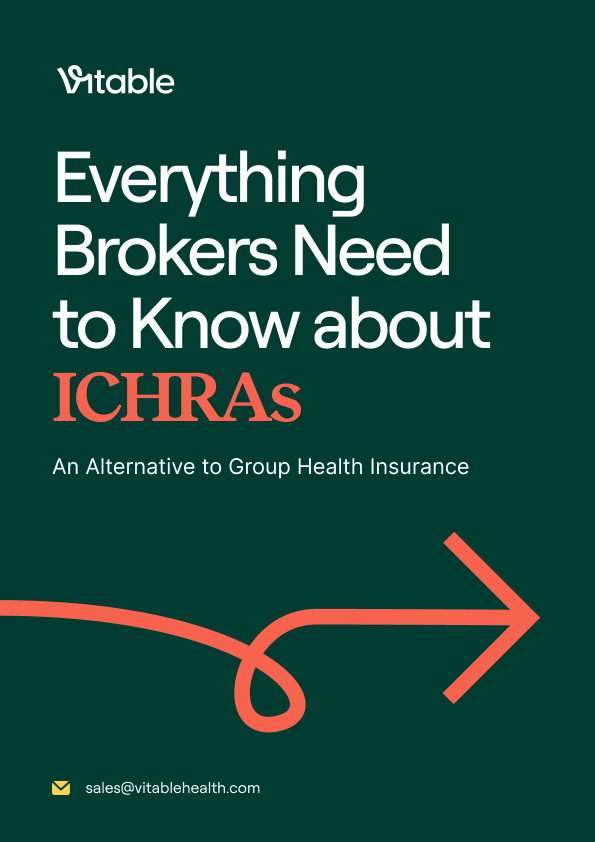HRA Solutions for ACA Compliance in 2025: Leveraging ICHRA

HRA Solutions for ACA Compliance in 2025: Leveraging ICHRA
Keeping up with healthcare regulations may not be glamorous, but it’s essential if you’re an employer looking to avoid costly penalties. 2025 marks the 15th anniversary of the Affordable Care Act (ACA), a historic achievement in United States (U.S.) healthcare reform, and with that milestone comes updated requirements that every employer needs to know. If you're exploring affordable, flexible ways to meet ACA mandates without ballooning your benefits budget, Health Reimbursement Arrangements (HRAs) might be the answer.
In this article, we’ll break down the ACA requirements for employers in 2025, explore how HRA solutions like Individual Coverage HRA (ICHRA) can help you stay compliant, and discuss how Vitable makes it easy to offer affordable, ACA-compliant coverage.
Understanding the ACA and What’s Required in 2025
The Affordable Care Act is a U.S. healthcare reform law that was designed to expand access to quality, affordable healthcare, and it has delivered on that promise. Since its passage in 2010, the ACA has helped reduce the number of uninsured individuals by over 20 million. As of 2025, more than 24.2 million Americans have enrolled in Marketplace coverage, and the U.S. is seeing the lowest uninsured rates in its history.
One of the ACA’s biggest impacts was making employer-sponsored health benefits more accessible for working Americans, especially hourly workers, who are often left behind by traditional insurance models. By offering subsidies to those earning up to 400% of the federal poverty line (FPL) and expanding Medicaid to include more low-income adults, the ACA reshaped how coverage is delivered across industries.
It also introduced new responsibilities for businesses. Employers meeting certain size thresholds are required to offer affordable, accessible health benefits or face significant penalties. In the sections below, we’ll break down who is responsible for meeting these mandates and what is required in 2025.
Who Needs to Comply? Understanding Applicable Large Employers (ALEs)
Businesses that employed an average of 50 or more full-time employees (or businesses that employed mix of full-time and part-time employees whose hours worked adds up to 50 “full-time equivalents”) in the previous calendar year qualify as Applicable Large Employers (ALEs). These employers must comply with ACA mandates or risk substantial financial penalties.
ALEs include:
- Full-time workers clocking 30+ hours per week
- Part-time employees, whose hours are combined to calculate full-time equivalents (FTEs)
ACA Employer Requirements for 2025
If you're an ALE, here’s what the ACA requires from your business in 2025:
- Offer Minimum Essential Coverage (MEC): You must offer MEC to at least 95% of full-time employees and their dependents, and that coverage must also meet minimum value (MV) standards. Learn more about MEC here.
- Ensure Affordability: The plan must be affordable according to IRS guidelines to avoid the "Schedule B Penalty." For 2025, affordable coverage means the lowest-cost self-only MEC plan cannot exceed 9.02% of the employee’s household income.
- File IRS Forms 1094-C and 1095-C: ALEs must submit Forms 1094-C and 1095**-**C to report whether they offered affordable MEC plans with minimum value to their full-time employees.
Failing to meet these requirements could result in significant financial penalties of up to $7,250 per employee, so aligning your benefits strategy with ACA compliance is critical. That’s why aligning your benefits strategy with ACA regulations, through solutions like ICHRA, is key.
HRA Plans That Help You Stay ACA-Compliant
An HRA (Health Reimbursement Arrangement) is a tax-advantaged benefit that allows employers to reimburse employees for qualified healthcare expenses, including health insurance premiums. HRAs are one of the most flexible and cost-effective ways for businesses to meet ACA requirements, while also giving employees more choice and control over their healthcare.
The HRA option for 2025 ACA compliance is the Individual Coverage HRA (ICHRA), which is available to businesses of any size and can be tailored to different employee groups. With an ICHRA, employers provide a set monthly allowance, and employees use those funds to purchase their own individual health insurance plans, typically through the ACA Marketplace or a private exchange.
What makes the ICHRA so attractive is its customizability and scalability. Employers can vary reimbursement amounts by employee class (such as full-time vs. part-time, salaried vs. hourly, or by location), and there are no annual contribution limits. As long as the plan design meets MEC and affordability standards, the ICHRA can fully satisfy ACA employer mandates.
For employers seeking flexibility and predictability in their healthcare spending—without sacrificing compliance—ICHRA is a smart solution.
How ICHRA Meets ACA Affordability Standards
As mentioned above, to satisfy the ACA employer mandate, an ICHRA plan must be designed to offer coverage that is affordable and fulfills the MEC and minimum value standards. Let’s break this down.
Affordability
For 2025, the ACA defines affordable coverage as a plan that costs the employee no more than 9.02% of their household income for the lowest-cost silver-level Marketplace plan available in their area (for self-only coverage). Since most employers don’t have access to household income data, it can make it challenging for the employer to understand what is affordable to the employee. To circumvent this, the IRS allows the use of safe harbors to determine affordability.
These safe harbors include:
- W-2 wages
- Rate of pay
- Federal Poverty Line (FPL)
- Employee’s geographic location (to determine the local Marketplace plan costs)
- Look-back method (using prior year’s plan prices)
By subtracting your ICHRA allowance from the lowest-cost silver plan premium, you can determine whether the remaining cost is below the 9.02% threshold. If it is, your ICHRA is considered affordable.
Minimum Value:
The second part of determining if an ICHRA is ACA-compliant is meeting the minimum value requirement. The employee’s selected plan must also meet the minimum value standard, meaning it covers at least 60% of expected healthcare costs and includes substantial physician and inpatient hospital services. Most major medical plans purchased through the ACA Marketplace meet this requirement; however, some plans do not, including short-term health plans, healthcare sharing ministries, and TRICARE. These plans aren’t eligible for reimbursement under an ICHRA.
The good news is that if your employee is enrolled in a non-qualifying plan, the introduction of an ICHRA qualifies them for a Special Enrollment Period. That allows them to shop for a qualified plan that meets both MEC and minimum value standards.
But you don’t have to worry about navigating these details—Vitable handles it all for you. From affordability calculations to employee education and enrollment support, we ensure your ICHRA is designed to meet ACA requirements and deliver real value to your team.

Download 2025 Employer Guide to ICHRA
Vitable’s ICHRA Guide gives employers a clear, step-by-step resource for building smarter, ACA-compliant benefits.
This guide explains how ICHRAs work, who qualifies, and how Vitable simplifies setup, onboarding, reimbursements, and compliance — while giving employees more flexibility, control, and care.

Download Vitable’s 2025 Broker’s Guide to ICHRA
The Broker Guide to ICHRAs is a comprehensive resource that helps brokers understand, sell, and manage Individual Coverage HRAs with confidence.
This guide covers everything from compliance and class design to administration flows, case studies, and how Vitable streamlines quoting, enrollments, and reimbursements for brokers, employers, and employees.
How to Set Up ACA-Compliant HRA Plan
Setting up an HRA plan may sound complex, but it doesn’t have to be when you have a trusted HRA administrator. The Vitable platform makes it easy to ensure ACA compliance by verifying that employees are enrolled in individual health plans and consistently paying their premiums. Our team of licensed experts is available to guide your employees through the enrollment process, answering questions and offering support every step of the way. And because regulations vary by state, we work with a trusted network of licensed agents across the country to ensure a smooth, compliant experience—no matter where your employees are located.
Here’s How It Works When You Partner with Vitable
Setting up an ICHRA plan doesn’t have to be complicated, especially with Vitable by your side. We handle the details, so you can focus on what matters most: running your business.
- Plan Design Made Simple: We’ll work with you to design a compliant ICHRA plan tailored to your business goals and workforce needs.
- Set a Smart Budget: Our team will help you determine a monthly reimbursement amount that aligns with IRS affordability standards, ensuring your plan meets all the necessary requirements.
- Customize by Employee Class: Want to offer different benefits for full-time, part-time, or remote workers? We’ll help you create employee classes and configure allowances accordingly.
- Employee Communication, Covered: We’ll assist with distributing required notices and educating your team on how the benefit works, ensuring a smooth rollout and strong engagement.
- Ongoing Support & Verification: We handle monthly tracking to verify employee premium payments and maintain compliance—no chasing paperwork, no guesswork.
With Vitable, setting up and managing your ICHRA is easy, efficient, and fully supported every step of the way.
Better Benefits Start with Vitable
At Vitable, we help businesses offer affordable, ACA-compliant healthcare solutions that actually work for hourly workers and underserved teams. Every plan we offer—whether an HRA, MEC plan, or DPC membership—is designed to improve health outcomes while reducing costs and complexity.
Every Vitable plan includes:
- Unlimited primary care and urgent care
- Access to over 1,000 free prescriptions and labs
- A mental health program tailored for everyday workers
- Same- or next-day appointments
- Annual wellness visits and physicals
- No copays, coinsurance, or deductibles
- Free dependent coverage
No networks, no surprise bills, and no wasted spend—just better benefits built for your workers.
Ready for Better Benefits?
Let’s build a health benefits strategy your employees will actually use and your finance and operations teams will appreciate. We’ll walk you through your options, run a cost-benefit analysis, and design a custom HRA plan that keeps your business compliant and competitive.
Book a free consultation with Vitable today!
Frequently Asked Questions
How does the "Schedule B Penalty" work?
The "Schedule B Penalty" is related to the affordability requirement set by the IRS for businesses offering health insurance. Companies might face penalties if the insurance offered is not affordable according to IRS criteria. Vitable’s role in tailoring Individual Coverage Health Reimbursement Arrangements (ICHRA) helps ensure that reimbursement levels align with affordability metrics, assisting businesses to avoid these penalties.
What are some essential benefits covered under MEC health plans?
Minimum Essential Coverage (MEC) health plans offered through exchanges include various essential benefits such as preventive services, emergency services, prescription drugs, maternity and newborn care, mental health services, and more. These benefits ensure comprehensive coverage for individuals.
How can Vitable’s platform ensure employees are consistently enrolled in individual healthcare plans?
In the Vitable platform, employees submit documentation every month showing proof of payment for their insurance premium charges, ensuring that the plan is still active.
What are some examples of government programs that might make someone ineligible to purchase insurance through the ACA marketplace?
Government programs like Medicaid, Medicare, and CHIP (Children's Health Insurance Program) could render an individual ineligible to purchase insurance through the ACA marketplace. Additionally, being incarcerated, not a U.S. citizen, nor a lawfully present immigrant could impact eligibility.
How does the ACA's emphasis on preventive services and essential health benefits affect healthcare management?
The ACA's mandate for preventive services and essential health benefits without cost-sharing has improved health management. Individuals have better access to preventive care, leading to earlier detection and management of health issues, ultimately contributing to healthier populations.
Ready to learn more?
Stay ahead with the latest insights on healthcare, benefits, and compliance—straight to your inbox.
Get a quote
Get a personalized health benefits quote tailored to your company’s unique needs.
Vitable helps employers provide better healthcare to their employees and dependents by improving accessibility, cost, and quality.